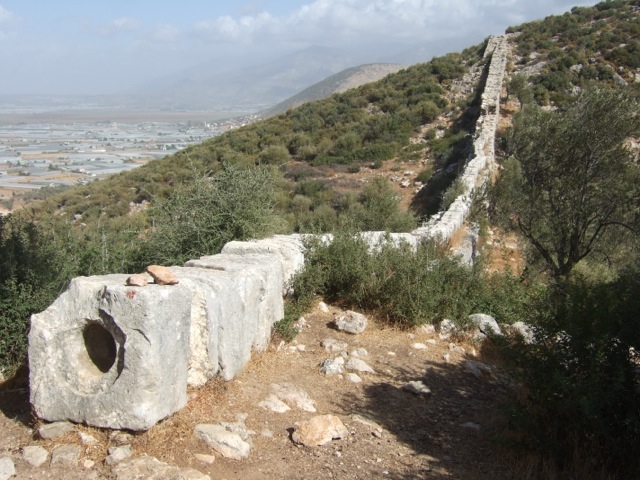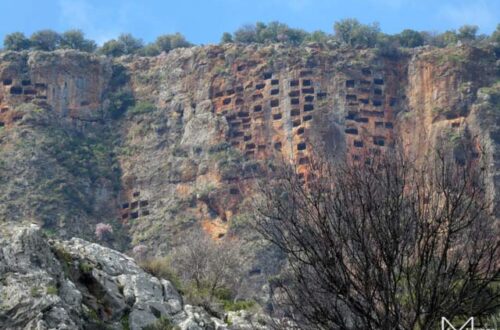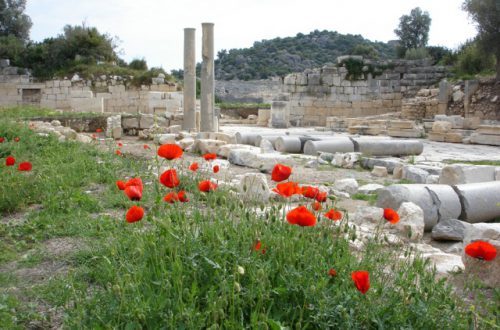
The Symphonic Aqueduct At Delikkemer
Photographs by Mike Vickers
Feature photo above: View along the aqueduct showing the size of the water conduit
Here’s a question for you: What’s over 200 metres long, stands 10 metres high in the middle, weighs thousands of tonnes, was built 2000 years ago, has no moving parts whatsoever and is absolutely vital for supplying a city of thousands with fresh water? Oh, yes, one more thing – this venerable object magically makes that water flow uphill! Any idea? Well, let me introduce you to the reverse symphonic aqueduct at Delikkemer.
A symphonic aqueduct? Come on, surely not. Have we actually discovered the inspiration behind Handel’s Water Music? Regretfully, no, but recently a friend was searching online for this aqueduct and Google, bless its condescending but confused electronic mind, auto-corrected ‘siphonic’ into ‘symphonic’ because it assumed we’d made a mistake and that it knew better than we did. Ah, the arrogance of technology.
I have an interest in archaeology. I’ve never gone as far as to wear plaid shirts with elbow patches, nor let my hair sprout with wild bushy exuberance, and I’m far too old to get down on my hands and knees with anything approaching elegance or dignity, but I do find the ruins of former civilizations fascinating. When we stand in these ruins, the only thing that separates us from them is the steady passage of time. Where there is now quiet serenity and stillness, the smell of cooking once wafted, children played, hawkers yelled, sheep bleated, lovers whispered and families and friends chattered and squabbled, in fact everything we still do nowadays – but with a lot less texting!
Over the years I’ve seen some remarkable sights in this archaeologically fecund country, from the glory of Ephesus to the sculptural magnificence of Aphrodesias, but without doubt the most impressive monument I’ve ever encountered is the Delikkemer reverse siphon. I did think about giving it a mention in my recent article on the city of Patara, one of my very favourite historic sites, but felt that this impressive example of ancient engineering warranted a piece all of its own.

Located just outside Kalkan, the siphon was an essential component of the system supplying fresh water to the only major port city of the Lycians. Those of you who are familiar with Patara know that is it located amongst the shifting sand dunes at the southern end of Patara beach in an area devoid of any useful water supply. To exist, a city requires lots of water, and it requires it all year round. Obvious, really, so the city fathers needed to find a spring that could offer the necessary capacity and reliability, and the nearest was quite a way inland up in the hills behind Kalkan, close to the village of Islamlar.
Islamlar is some distance from Patara, but also, handily, at a much higher elevation. The engineers who designed and built this 22.5km long gravity aqueduct so long ago were highly skilled craftsmen who knew exactly what they were doing. The gradient was excellent, giving good flow along the masonry channel, which was lined with mortar to make it waterproof and covered with cap stones to prevent contamination and loss by evaporation. Even today, parts of this original channel remain and can be seen running alongside the Lycian Way.

So, the course of the aqueduct was planned, but there was one major obstacle. To maintain the constant gradient needed to allow water to flow all the way to Patara, the aqueduct had to cross a dry valley, dropping down one side and climbing up the other, and that required the construction of something very special – a reverse siphon.
Fortunately, we’re talking about the Romans here, who were the absolute masters of water management. They had long understood the principles of the siphon, and knew the only solution to the problem was to build this wonderful structure. As long as the inlet to a siphon is higher than the outlet, water enclosed within a pipe can be made to flow uphill using the siphonic principle.

However, one of the biggest problems was water pressure. The siphon was 18 metres deep and the resulting pressure at the lowest part would have been substantial. To overcome this and prevent bursting, a line of chunky interlocking limestone blocks were laid across the top of the structure.
Each individual block is about 90cm square, 50cm thick, and is bored through with a 30cm diameter hole. On one side of the block this hole has a recess and on the opposite side a spigot. When offered together, the spigot of one block sits inside the recess of the next block, and so on. Once the joint is sealed with a quick lick of mortar – one of the Roman’s greatest inventions – you have a large diameter continuous pipe capable of resisting the water pressure experienced at the base of the siphon.

At Delikkemer, there are hundreds of these blocks, each weighing about 800kg. I think we can safely say some considerable effort was invested in every block, not only to accurately carve, but also to manoeuvre into position. Some have long been toppled by earthquakes, but many remain in position and still run across the top of the supporting wall.
However, there is plenty of evidence to suggest that the siphon was not always so substantial and even possibly pre-dated the Romans. The supporting wall appears to be Lycian, as indicated by the irregular block stonework. Romans, like the Greeks, preferred squared masonry. Also, scattered around the base of this wall are fragments of ceramic pipes.

Extremely bright people in white coats and possessing an intimate knowledge of bunsen burners have conclusively proved through analyzing the carbonate deposits on the interior of these pipes that this previous piped version of the siphon was brought into use in 51AD and survived for 17 years before suffering damage by an earthquake. The pipes were then discarded when the siphon was repaired and upgraded using the more substantial limestone blocks which we see today. How can we be certain of all this? Conveniently, there’s an inscribed stone lintel above one of the passageways through the wall which describes the repairs in detail.
Regarding the more mundane aspects of maintaining the siphon, rodding holes were bored into the tops of some of the blocks to clear obstructions, these holes no doubt sealed by removable wooden plugs. How clever is that? Some blocks also have longer spigots to allow for their easy removal for cleaning and maintenance. Without this facility the whole structure would have to be dismantled if one block in the middle happened to leak or be damaged. Again, this demonstrates consummate engineering expertise

Adjacent to the outlet of the siphon lie the ruins of a small structure, maybe a caretaker’s hut positioned there to watch over and maintain the siphon. I like to imagine there was a device that, when dipped into the channel, would make a sound if the flow was interrupted, warning of a problem. These were really clever people easily capable of constructing such a device, but my own preferred contraption involves an ingenious system of pulleys, peacock feathers and a particularly ticklish goat!


From Delikkemer, the aqueduct is still visible in places as it winds around the last hills before flowing down into Patara. On arrival in the city, a system of distribution tanks, water pressure reduction tanks, cisterns and ceramic pipes then distributed water around the city. There’s even a large spout on the side of the gate of Mettius Modestus, indicating a civic waterfall.

Considering its venerable age, the expertise exhibited at Delikkemer and the sophistication of the water system in Patara itself is admirable, but I suspect the disposal of the waste perhaps less so – no doubt it was emptied straight into the harbour. Ah, well…
Finally, here’s a thought. In 2007, summer flooding in England was some of the worst in living memory. The water treatment plant at Tewkesbury was overwhelmed by the Severn and forced to shut down, depriving Gloucester and Cheltenham of their mains supply. I remember this well because I lived in Gloucester. Life quickly became difficult and increasingly aromatic, and remained so for several weeks, during which the government came within a whisker of instituting a compulsory evacuation order for both towns. No water, no city. As it was back in Lycian times, so it remains today.
Directions to Delikkemer:
Take the D400 (hey, my favourite road!) down the coast towards Kalkan and Kaş. Descend into greenhouse country and pass the Kinik, Ova and Patara turnings on the right, then the Yeşilköy turning on the left. Just over a kilometre past this junction and immediately before the D400 swings to the left and starts to climb up the hillside, turn right up an unsigned minor road. Don’t worry, it’s the only junction and easy to see.
Drive up this road for a kilometre or so, taking several hairpin bends on the way, and park in the left-hand side of the road where you see the signpost indicating the Lycian Way. Follow the path towards Delikkemer and it will lead you to the siphon after about 200 metres. This path is actually the course of the aqueduct.



